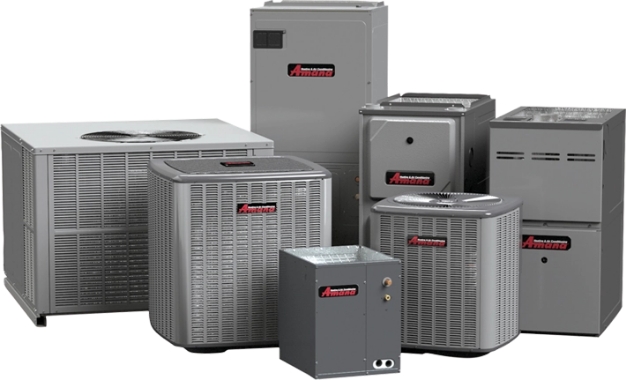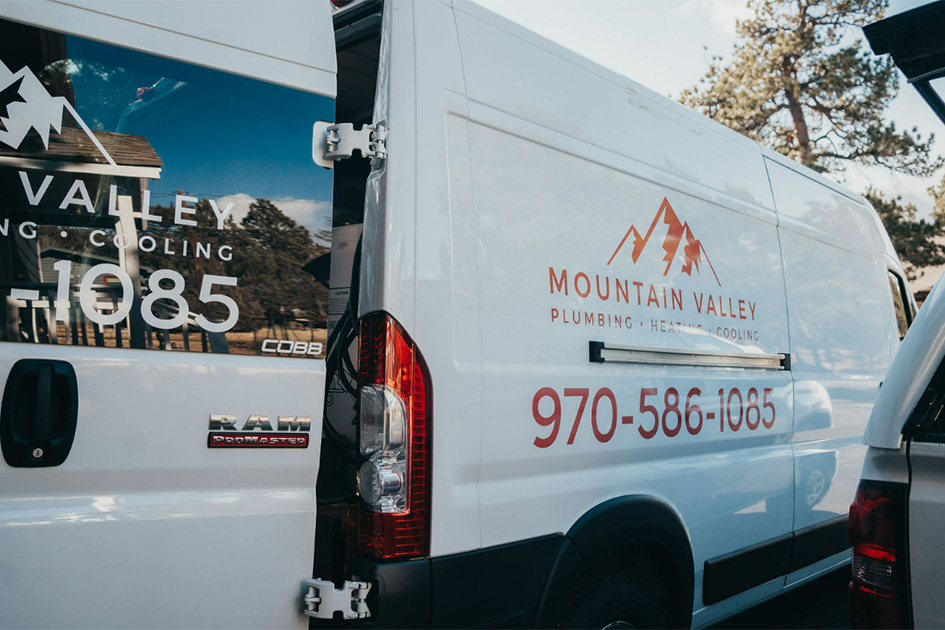Eco-Friendly Plumbing Solutions: How to Save Water and Lower Your Bills
Did you know upgrading to low-flow fixtures cuts your water use by up to 30%? By choosing eco-friendly plumbing, you help save water and reduce bills. Green plumbing lets you use water smarter, giving ecological and financial perks.
There are many ways to make your plumbing more eco-friendly. You can install low-flow fixtures and energy-efficient water heaters. You can also use greywater systems and catch rainwater. These methods greatly reduce your water use and help save our planet’s most precious resource.
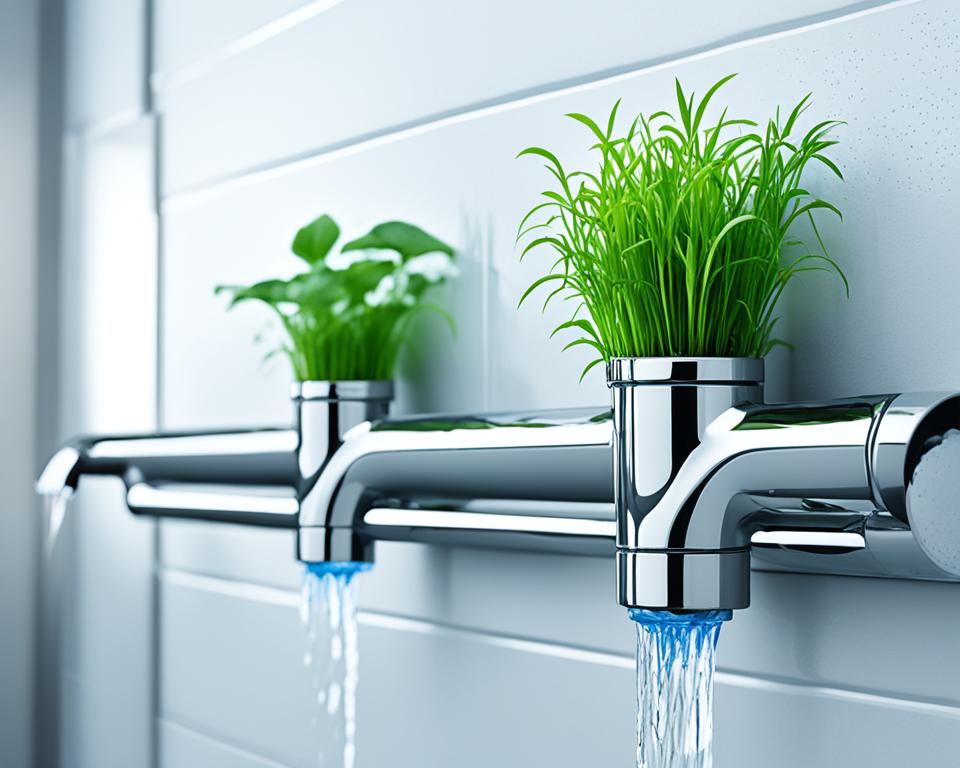
Key Takeaways
- Eco-friendly plumbing solutions contribute to both water conservation and cost savings.
- Using low-flow fixtures can cut water consumption by up to 30%.
- Energy-efficient water heaters can save homeowners up to $100 annually.
- Rainwater harvesting can conserve approximately 1,300 gallons of water per year.
- Regular plumbing maintenance is crucial to prevent leaks, which can waste up to 10,000 gallons of water annually.
- Implementing greywater systems can lead to water savings of around 40% in household consumption.
Table of Contents
The Importance of Eco-Friendly Plumbing Solutions
Adopting eco-friendly plumbing helps save water and cut down on bills. In Dallas, where droughts are on the rise, these solutions are critical for a sustainable future. They help us save important water resources and make the environment healthier for the next generation.
Low-flow toilets, faucets, and showerheads are key in reducing water use. A low-flow showerhead can use as little as 2 gallons per minute, unlike standard ones which use more. This shows the big water-saving impact of efficient fixtures.
Adding a dual-flush toilet to your home can save thousands of gallons of water annually. These upgrades are good for the planet and your pocket. Energy-efficient water heaters add to the eco-friendly benefits by using less energy and providing hot water when needed.
Insulating your hot water pipes and tanks is important to prevent heat loss and boost energy efficiency. It’s also vital to use eco-friendly materials like lead-free pipes and safe sealants, which promote health, safety, and sustainable plumbing.
Greywater recycling and rainwater harvesting maximize water efficiency. These systems show a deep commitment to saving water, leading to a significant decrease in water use. Regular plumbing checks help avoid repairs and keep the system working well.
| Eco-Friendly Solutions | Benefits |
|---|---|
| Low-Flow Fixtures | Reduced water consumption, lower utility bills |
| Dual-Flush Toilets | Savings of thousands of gallons of water annually |
| Energy-Efficient Water Heaters | Lower energy bills, on-demand heating |
| Greywater Recycling | Maximizes water efficiency, reduces overall usage |
| Pipe Insulation | Improves energy efficiency, prevents heat loss |
Install Low-Flow Fixtures
Low-flow fixtures help save water and are good for both the planet and your pocket. These eco-friendly options, like low-flow showerheads and dual-flush toilets, cut down on water use without losing performance. By choosing these, you’re making a big difference in water conservation.
Benefits of Low-Flow Showerheads
Low-flow showerheads need about 2 gallons of water per minute. This is less than standard ones that use up to 5 gallons. You could cut your shower water use by 30-50%, saving money on your water bill.
Using these showerheads also helps the environment. It’s important because the United Nations says half the world might soon face water shortages.
Installing Dual-Flush Toilets
Dual-flush toilets are great for saving water. They let you choose how much water to use depending on the waste. A family of four can save about 4,000 gallons of water each year with them.
These toilets not only save water but can also make your home more attractive to buyers looking for green options.
| Fixture Type | Water Usage per Minute/Flush | Typical Savings |
|---|---|---|
| Standard Showerhead | 5 gallons | — |
| Low-Flow Showerhead | 2 gallons | Up to 50% |
| Traditional Toilet | 6 gallons per flush | — |
| Dual-Flush Toilet | 1.6 gallons (liquid) / 3.2 gallons (solid) | Over 50% |
Fixing Leaks Promptly
It’s crucial to fix leaks right away to keep plumbing eco-friendly. Small leaks can cause a big waste of water as time goes on. This waste spikes your utility bills. Check your plumbing regularly to catch leaks early on. Watch out for water stains, damp areas, or faucets that drip.
Using leak detection systems helps a lot with eco-friendly plumbing. They find leaks quickly, saving water and money. Monitoring how much water your house uses helps find problems early. This leads to fast repairs of leaks.
The following table shows how fixing leaks saves water and money:
| Type of Leak | Estimated Water Waste (per day) | Annual Cost Impact |
|---|---|---|
| Dripping Faucet | 5-10 gallons | $50 – $100 |
| Running Toilet | 30-300 gallons | $200 – $700 |
| Leaky Pipe | 100-1,000 gallons | $800 – $2,500 |
Fixing leaks on time does more than save water. It makes your home work better all around. By acting early, you help keep plumbing sustainable. This reduces waste and keeps your plumbing working longer. Small repairs now can mean big savings later.
Energy-Efficient Water Heaters
Energy-efficient water heaters are key for Sustainable Plumbing. They cut down on energy use while giving you hot water. Picking the right heater can help save water and reduce your bills.
Types of Energy-Efficient Water Heaters
There are many energy-efficient water heaters to fit different needs:
- Tankless Water Heaters: These heat water on demand and don’t need a storage tank. They save energy and provide endless hot water.
- Solar Water Heaters: They use the sun’s power to heat your water. This can greatly reduce your energy costs.
- Heat Pump Water Heaters: They pull heat from the air to heat water. This makes them much more efficient than traditional electric heaters.
Insulating Your Water Heater
Adding insulation to your water heater boosts its efficiency. Wrapping the tank and pipes helps keep the heat in. This means it uses less energy to keep water warm. Doing this lowers your energy bills and supports Sustainable Plumbing and Water Conservation.
| Type of Heater | Energy Source | Estimated Energy Savings |
|---|---|---|
| Tankless Water Heater | Electric/Gas | Up to 30% |
| Solar Water Heater | Solar Energy | 50-80% |
| Heat Pump Water Heater | Electric | Up to 60% |
Utilizing Greywater Recycling
Implementing greywater recycling is key to saving water at home. It uses water from showers, laundry, and dishwashing for things like watering plants and flushing toilets. This way, you can use less water and save money on your water bills.
How Greywater Systems Work
Greywater systems capture water from your home’s sinks, bathtubs, and washers. They then clean this water and reuse it for non-drinking purposes. This recycling helps save water, puts less strain on sewers, and can lower your utility costs. Proper cleaning and regular system checks are important to keep the water safe for use.
Benefits of Greywater Recycling
Using greywater recycling at home has many benefits. It can cut down non-drinking water use by 50-70%. This means you could see a 25-40% reduction in your water bills. Moreover, using less water helps the environment by reducing your carbon footprint and energy used for water treatment. It’s a smart choice for both your wallet and the planet.
| Benefit | Description | Potential Savings |
|---|---|---|
| Water Usage Reduction | Reduces water usage in irrigation and toilet flushing | 50-70% |
| Monthly Water Bill Savings | Lower utility costs through effective water reuse | 25-40% |
| Carbon Footprint Reduction | Lessens energy required for water treatment | 1000-1500 lbs of CO2 annually |
| Environmental Impact | Decreases pressure on local water sources and sewage systems | Varies based on system efficiency |
By choosing greywater recycling, you help in water conservation while saving money. It’s a great step towards living more sustainably.
Harvesting Rainwater
Rainwater Harvesting is a key part of Sustainable Plumbing. It lets you catch and store rainwater, reducing your need to use city water. You can use collected rainwater to water plants; this helps save water, which is great for saving resources.
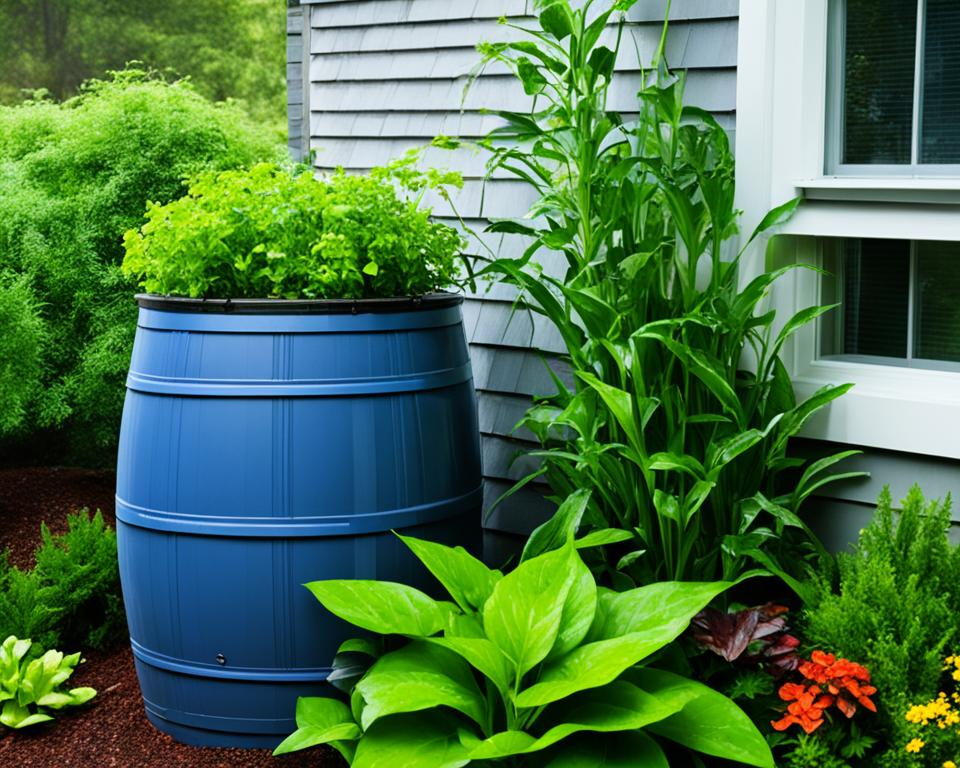
To start collecting rain, you might need rain barrels or big tanks. The cost to set this up can be high at first, but you’ll save money on your water bills later on. As water and energy costs go up, getting a rainwater system is a smart financial move.
Houses with systems like rainwater harvesting sell faster and for more money. These methods save resources and make homes healthier and more comfortable, which is a win for the environment and for you.
To learn more, consider eco-friendly plumbing solutions. These include rainwater harvesting to use water wisely.
Smart Landscaping for Water Conservation
Smart landscaping makes your outdoor areas look good and helps save water. By using plants that don’t need much water and smart watering systems, you can keep your garden beautiful with less water. It’s a great way to be eco-friendly and efficient.
Choosing Drought-Resistant Plants
Drought-resistant plants are key to saving water in your garden. These tough plants don’t need much water to flourish. Plus, plants native to your area usually do better, making your garden more sustainable.
- Native plants are easier to maintain and adapt well to the local environment.
- Drought-resistant varieties can significantly lower irrigation needs.
- Reducing water usage aids in the conservation of precious water resources.
Implementing Efficient Irrigation Systems
Efficient watering systems are essential for using less water in your garden. Systems like drip irrigation put water right at the plant roots, reducing waste. Adding mulch helps keep the soil moist longer.
- Smart irrigation can cut outdoor water consumption by up to 50%.
- Drip systems reduce evaporation and runoff, delivering water where it’s needed most.
- Utilizing timers and sensors can enhance system efficiency and minimize human error.
Regular Maintenance for Sustainable Plumbing
Regular maintenance is key for green plumbing systems. It helps find leaks and other problems early. About 25% of water in buildings is wasted.
By doing regular checks, you can cut down on this waste. This supports green practices.
Here are some green practices for maintenance:
- Inspect and tighten connections to prevent leaks.
- Clean aerators on faucets to keep water flowing well.
- Service tankless water heaters regularly. This can save up to 34% on energy.
Choosing green plumbing products is vital. They help you live more sustainably. For example, PEX pipes are better than old materials. They improve water flow and are more sustainable.
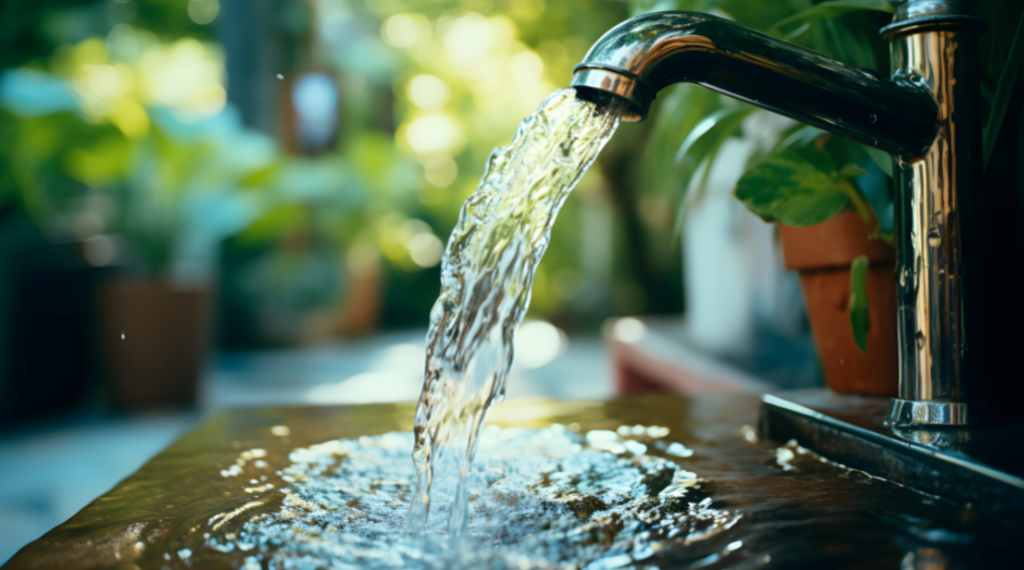
Expert maintenance makes your plumbing efficient. Fixing leaks quickly can save a lot of water, and regular checks not only save water but also cut your bills.
The average household spends about $876 a year on water. Proper plumbing care can lower this cost.
| Maintenance Task | Benefits | Frequency |
|---|---|---|
| Leak Inspections | Save thousands of gallons of water | Quarterly |
| Faucet Aerator Cleaning | Maintain efficient water flow | Bi-annually |
| Tankless Heater Servicing | Maximize energy efficiency | Annually |
| Pipe Inspections | Prevent major plumbing issues | Every 1-2 years |
Adding these tasks to your routine encourages saving water. You help the planet by keeping your home’s plumbing in good shape. And you adopt eco-friendly habits.
Conclusion
Choosing eco-friendly plumbing helps both your budget and the planet. With steps like installing low-flow faucets and using greywater systems, big savings can happen. These changes cut down on water and power use.
This leads to smaller utility bills and helps save water. New plumbing tech, like tankless water heaters and toilets that use less water, are key. They use less water, helping our environment.
Even small acts, like shutting the tap when brushing, save a lot of water. So, every eco-friendly choice in your home matters. It’s not just about better plumbing; it’s about a better future.
By starting now, you save resources for the future and boost your home’s efficiency. Moving towards an eco-conscious lifestyle is vital. It helps our community value water and the environment more.
FAQ
What are eco-friendly plumbing solutions?
Eco-friendly plumbing solutions focus on saving water and reducing bills. They include low-flow fixtures and greywater systems. Rainwater harvesting is another key method.
How do low-flow fixtures help save water?
Low-flow fixtures, like showerheads, cut water use significantly. For example, low-flow showerheads can save up to 50% water. This means smaller water bills but still great showers.
What is greywater recycling, and why is it important?
Greywater recycling uses water from activities like showers for other needs. This is important because it saves fresh water for other uses. It reduces our need for city water, which is great for the planet.
How can I fix leaks to conserve more water?
Fixing leaks fast is important because they waste a lot of water. By doing regular check-ups and fixing leaks, you save water at home.
What are the benefits of energy-efficient water heaters?
Energy-efficient water heaters save on your energy costs. They need less energy for heating water. Tankless and solar heaters are even better for saving energy and helping the environment.
How does rainwater harvesting work?
Rainwater harvesting means catching and storing rain for later. It helps cut down on use of city water. You can use this stored water for your garden, which is a smart way to manage resources.
What smart landscaping techniques can help with water conservation?
Smart landscaping uses plants that need less water and efficient watering systems. Drip irrigation is one method that saves water. These choices make your garden better for the environment.
Why is regular maintenance essential for eco-friendly plumbing?
Regular check-ups and cleaning of your plumbing prevent leaks. This keeps your eco-friendly plumbing in good shape. It helps achieve your goals for saving water and being more sustainable.






